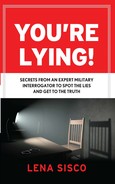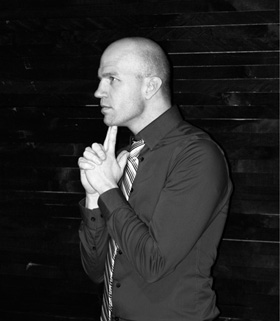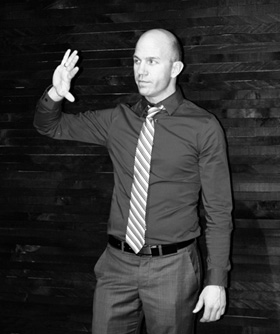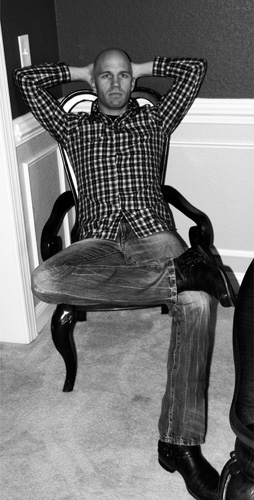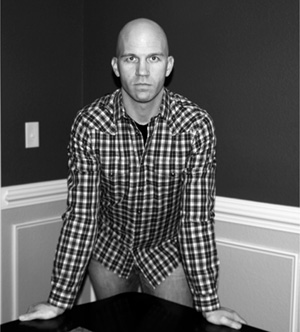5
R Is for Relax
The first step in the REBLE program is to relax. A big part of this will involve cultivating some self-awareness. Before you can begin to read other people you have to know what your own body is saying. For example, when I was interrogating detainees in GTMO, do you think for one minute they would have given me information if I looked scared, incompetent, or dishonest? Remember that the only way to look confident is to feel confident. How is your body posture right now, as you are reading this book? Are you slouched over with your shoulders rolled inward and your chin down? Or do you have your chest puffed out, your shoulders back, and your chin up? Are you sitting with your ankles crossed, or with one leg crossed over the other knee in a figure four? Do you look confident and self-assured, or timid and unsure? When people look confident, they are likely feeling relaxed and calm. When people look unsure of themselves, they are likely feeling uncomfortable and nervous. You need to understand how to look relaxed in order to get to the next step in my five-step program: establish rapport. No one will want to even talk to you, let alone build rapport with you, if you look tense or skittish.
Failure and Acceptance
Feeling confident about who you are takes some time and some acceptance of your life traveled thus far. We have all heard the saying “If at first you don’t succeed, try, try again.” Don’t give up, even after you experience failure. We all have and will continue to stumble, but you must learn to experience and embrace failure, because ultimately it will lead to your success. I am speaking from firsthand experience on this subject, and I’m sure you can, too. When we fail at something, a lot of negative emotions are associated with that failure: shame, guilt, fear, doubt, inadequacy, embarrassment, unworthiness, nervousness, and even grief. After failing at a task, a mission, a goal, or an assignment, you may think those around you will always remember you for your failure; you may feel that you’ve lost credibility permanently, which ultimately erodes your self-confidence. We tend to be our own worst critics. Other people forgive our mistakes far more easily than we can forgive ourselves.
I’m going to share a couple of failures I have experienced in my life and tell you what happened right after each one. My first story goes back in time to my college years. The four years I spent working toward my bachelor’s degree were divided into two majors: accounting, following Dad’s footsteps and failing miserably, resulting in being put on probation; and anthropology, which got me on the Dean’s List. I wish then I understood why I failed at accounting so I wouldn’t have thought I was just stupid. At that time I was being groomed to take over my dad’s successful CPA business, but I had no idea that I had a learning style preference, or that there even was such a thing. I had a heart-to-heart with my father, explaining that numbers drove me mad and that understanding mathematical equations was like trying to read Greek. (Actually, I learned to read and speak Greek years later, and it was a breeze!) What I didn’t realize was that I was and am an “Intuitive” (according to Jungian personality preferences); I take in a process information conceptually, I follow my inspiration, and I imagine possibilities for the future. I hated rules, deadlines, details, and processes. Tell me to create a new theory on cross-cultural communication? I was all over it. Tell me to balance a checkbook? I would wallow in frustration and defeat. My dad, on the other hand, takes in information as a “Sensor”; he enjoys factual, detail-oriented information and prefers to have rules, instructions, and processes. This way of being and approaching the world makes sense to him and it’s easy for him, which is why he gravitated toward the field of accounting and is a very successful CPA. I also realized I wasn’t stupid. So I decide to change majors to anthropology and archaeology, even though I had no clue where was I going to find a job “digging rocks,” as my dad would say. But I was in heaven, loving what I was learning and excelling in all my classes.
After I graduated with a BA in anthropology, I decided with my newfound confidence to apply to Brown University for graduate school. I still don’t know how or why, but I was accepted. It was probably one of the biggest challenges in my life, but I didn’t let it scare me; I was ready to jump in! I ended up falling on my face, quite a few times, but I always got back up again. During those two long years I experienced failure more than a few times. For example, during an art history lecture, my professor called on me to discuss a question. I will never forget what happened next. I became so nervous that my body started doing things I couldn’t control. (Now, of course, I know why: It was the physiological response to the cortisol, that pesky stress hormone, being released in my body.) My voice trembled, the pitch of my voice went up, my hands shook like crazy, and I started swallowing hard because my mouth suddenly felt like it was filled with cotton. I fell apart. I was so humiliated. Why am I so scared of people? It’s ridiculous, I thought. I was terrified of looking stupid in front of people, and of course I did just that. Although no one let on, I knew that everyone had seen me lose it. I got so mad at and down on myself that I felt as though I didn’t belong there. The incident played in my mind over and over all night long.
When I woke up the next day, I was no longer humiliated and embarrassed; I was angry. Now I was on a mission to prove to that class—and to myself—that not only did I know the material, but I could present it professionally and eloquently. I wasn’t going to let a professor and a handful of students scare me! When our end-of-semester class presentations came around, I volunteered to go first. There was no way I was letting that last horrible impression of myself linger. I knew I had it in me and I was determined they were going to see me confidently present for two hours on my topic. I even put more pressure on myself by using dual slide shows running simultaneously (this was 1995, so we didn’t have the technology we have today). I gave the best presentation I had given in my life up to that point. I was so happy with myself that I barely noticed I was getting a standing ovation for my presentation. The day I fell apart never haunted me again; in fact, I was thankful for the strength and confidence I found in myself because of it. Of course it didn’t cure my insecurities, and I still felt them from time to time during the next year and a half, but it certainly was a huge stepping-stone and learning opportunity for me that I will never forget or regret. I overcame my fear by forcing myself to appear, act, and feel confident, and you can, too.
Why am I sharing this with you? To prove to you that I am the best example of my theory that once you act and hence feel confident, you can conquer your greatest fear. Did you know that the most common fear is the fear of public speaking? It’s not a life-or-death situation, yet it is the number-one most fear for most people. The fear of failure and shame, based on how others perceive us, is very powerful. America is a society of guilt; some countries in the Middle East are societies of shame. Guilt, shame, and embarrassment cause us fear, and that fear is just as crippling as when our lives are being threatened. You’re going to need confidence to use the tools in this book and use them successfully. If I have confidence in you to use them, you need to do your part and find it. Deal? So don’t worry about failing or screwing up. We all do in some form or another. When it happens, learn from it instead of getting down on yourself. Every human being on this planet will fail at something, at some point, so you are not alone.
Here are a few of my favorite quotes about confidence. Hopefully you’ll find them encouraging, too:
• “Confidence doesn’t come from always being right; it comes from not fearing to be wrong.” (Peter T. Mcintyre)
• “If you are going to doubt something, doubt your limits.” (Don Ward)
• “People who say it cannot be done should not interrupt those who are doing it.” (George Bernard Shaw)
• “True confidence is the mentor; professed confidence is the aggressor.” (That one’s mine.)
A former colleague of mine—we’ll call him Jack—took a senior position a bit outside his comfort zone. Jack was liked by many and had a good work ethic; he was also a mentor to junior employees and an enthusiastic team player. Until he stepped into a management position. Up until this point in his career Jack was “one of the guys” who had your back in tough times, but he hadn’t held a managerial position before. Knowing he was a bit inexperienced didn’t engender humility, unfortunately; it made him feel that he really had to prove himself in this position. It was good that he accepted the challenge, but bad that he became aggressive with those who worked with him.
He began to alienate his colleagues and friends by being brash, confrontational, and emotionally heated. He lost all sense of diplomacy. Once he was down in the trenches with his fellow soldiers; now he was barking commands from his throne. How did this new position change him from a person who everybody respected to a person everyone disrespected? You can probably guess. His lack of confidence in himself made him aggressive. He was mad at himself for not having the knowledge to hit the ground running in this new position and was worried that people would see that he didn’t have all the answers—which would have been okay! But he thought he would lose respect if he asked for advice. What he didn’t know is that he would have gotten more respect if he had done that, not less. His anger and worry turned him authoritative to the point of being disrespectful; it was all a smokescreen to get people to think he was confident. Thankfully for Jack, those who knew him overlooked his displays of aggression. You have probably seen people who compensate for lack of confidence the same way. Or maybe you are one of these yourself. They equate being bossy and aggressive with confidence, when it’s actually a telltale sign of quite the opposite. Look at Anthony Weiner and Lance Armstrong and how condescending, confrontational, and even aggressive they were to the press prior to admitting their lies. They were both trying to convince the public of their lies and they did so by bullying those around them.
Another experience I’d like to share with you that’s relevant to feeling relaxed and confident happened to me when I joined the Military Reserves and experienced personal failure, again, to the point I was so disappointed in myself that I had no other choice but to conquer my fear. But this time the consequences were far worse than having a bunch of graduate students see me get a case of stage fright. I had just been mobilized for one year of active duty service and was being trained as a certified Department of Defense (DoD) interrogator. Basically I had been sent on a trip to the Caribbean island of Cuba, where I stayed at a .5-star resort surrounded by tourists—I mean terrorists—eating gourmet cuisine that came conveniently wrapped up all in one package. I knew I was not in Rhode Island anymore.
When I arrived I had exactly one day to get my housing assignment, check in, and learn the lay of the land. The next day I went to the prison where I would be working every day, to get a turnover from the team I was relieving and a tour of the camp. As I was escorted to the trailers we used as interrogation booths, the guard opened the door and an overwhelming smell of sweat, urine, and vomit covered up by lemon air freshener hit me in the face as I stood in the hot sun. I wanted to turn around and run, but obviously I couldn’t. This was where I would be interrogating for the next five months for hours on end. How the hell am I going to work in this stench? I wondered.
The day finally came when I was scheduled to interrogate my very first detainee. When I was attending interrogation training in 1999, I never thought I was actually going to use my training in “real life.” Here was my chance. I met my interpreter at 0800 hours in my office, which turned out to be a small room in a trailer identical to the interrogation booth trailer, and we walked through three sally ports (secure controlled entryways to the prison) and past military guards escorting detainees in shackles to our destination: Yellow Trailer, Booth #7. During our walk I pre-briefed the interpreter I was to work with that day on how the interrogation was going to unfold. I told him how I was going to build rapport with the detainee, the topics I was going to question him on, the incentive items I was going to offer the detainee, where I wanted of all us to sit, when we would take breaks, how long we were going to be in the interrogation, and so on. In short, I had a plan. Yellow Trailer had about eight interrogation booths inside, buffered by observation booths on each side with two-way mirrors, one control booth at the entryway containing guards and video equipment, and a head, or latrine (depending on what branch of service you are in). As we waited in Booth #7 I heard the door open to the trailer and a guard shout, “Detainee on deck!” (GTMO is a Navy base; deck is the floor in Navy talk.) Here’s my guy, I thought. A real detainee. When the guards escorted detainees to their interrogation booths everyone had to stay in their rooms; no one was allowed to be in the hallway for security reasons. I heard the clanking of the chains around his feet getting closer and the heavy shuffling of his footsteps. I had no idea what he was going to look like. Would he be fierce and belligerent and fight the guards? Or would he be docile and weep once seated in the chair? My heart leaped into my chest. I felt my pulse quicken and pound in my head. I started to doubt my plan. Maybe I should stand, or sit, or move the furniture; or maybe I should have come in after the detainee.
Too late now—there he was at the door. The guards stopped him and asked me if it was okay to enter. I said yes and saw this this thin, messy-haired man in a bright orange jump suit and flip-flops enter the room. He looked at me and rolled his eyes. Great. I already felt defeated, because with that eye roll, he had the upper hand within a second. For the next hour I asked questions and got vague answers. I couldn’t build rapport, and he would not maintain eye contact. I could tell from his body language that he thought the whole thing was a joke. I felt humiliated. After only two hours I terminated the interrogation and sent him back to his cell. The interpreter and I walked back to my office, but I felt as though I was doing the walk of shame. What the hell am I doing here? I can’t do this, I said to myself. Not only did I feel like a failure, but, even worse, I was letting my fellow military members on the front lines down because I didn’t get any information out of that guy. I sent him back to his cell because I gave up. I didn’t sleep at all that night.
That next morning I had another interrogation at 0800 with a different detainee but with the same interpreter. The interpreter met me at 0730; he was an older man, very pleasant and nice, with a great, upbeat attitude. I thought to myself, You’re not going to see the same loser girl you did yesterday! That day he was going to see the real me, the confident, high-energy, quick-witted girl who scrutinizes every single body movement and every single word coming out of someone’s mouth, and who enjoys mental sparring to get to truth. I stood tall took a deep breath and said to myself, Bring it on. The next eight hours went by in the blink of an eye. I had pages and pages of notes. I had to end the interrogation so that the detainee and my interpreter could eat. I wasn’t even hungry, I was on such a high. That day on the walk back to my office I walked with my head held high. Never again would I allow a detainee make me doubt my ability or get the upper hand. I knew what I was capable of doing; it just took a little bit of anger to get past my fear of the unknown, find my confidence, and relax into this new environment. Right before we entered our offices my interpreter patted me on my shoulder and said, “That was impressive. I’d like to request to work with you while you are here.” And that was the start of my many follow-on successes at GTMO. In fact I had to beg my command to stay another month because I didn’t want to leave. The Commanding General of GMTO told my home command that I was “an asset here” and requested me to stay another month. I stayed. Oh, and when new interrogators would arrive and get the VIP tour of the prison and the interrogations booths, they would always ask me, “How do you stand that smell?” I would reply, “What smell?”
Are you starting to see a trend? It took failure and disappointment in myself to give me the inner strength to find my confidence and accomplish my goals, whether it was giving a killer presentation or getting intelligence information from detainees. I can look back now and view those two events as negative experiences with positive outcomes. Deep down, I knew I had the skills, knowledge, finesse, determination, and confidence; I just needed some help bringing it out. I found out how to relax and gain confidence, and I know you can do the same.
Think of a time in your life when you felt shame, embarrassment, and/or disappointment in your actions. Write down what happened and how you felt. What did you do afterward? What will you do if and when something like this happens again?
No one can make you confident; only you can. The question you need to ask yourself is: Are you willing to give up the fear of failure and challenge yourself to bring out your inner confidence? We all have it! I’m going to help you with this challenge by giving you some pointers on how you can tap into your inner confident you. These pointers will also be in your toolkit and checklist at the end of the book.
What Happens to the Body Under Stress
So let’s talk more about what actually happens inside the body when we become stressed, nervous, or anxious. My students used to ask me all the time, “How do I stop from being nervous?” I tell them exactly what I’m going to tell you; you have to not be nervous. Nothing like stating the obvious, right? Unfortunately, there is nothing you can do to stop the hypothalamus from causing the release of the stress hormone cortisol that we talked about in Chapter 2, or to prevent your body from responding physiologically as a result, at least not until the perceived threat or fear has passed. You have to learn to manage your emotions before you get to that state. Without getting too scientific I’m going to briefly explain the science behind what happens when the body is trying to protect itself when it perceives a threat.
Once a threat is identified and fear is established (and remember that a “threat” can be public speaking, not just being chased by a wild animal), the body goes into a fight-or-flight response; do you stay and fight the threat, or do you run away and evade it? Imagine that you are just about to go on stage, and even though you know your material inside and out, all of a sudden your heart starts pounding and your breathing becomes more rapid and shallow. The adrenal glands, located on top of your kidneys, release a surge of hormones that include adrenaline and cortisol. Adrenaline is released into your body when you feel stressed. You can feel the effects of it immediately; it increases your heart rate, elevates your blood pressure, and boosts immediate energy supplies. Another hormone that is released, norepinephrine (also called noradrenaline), focuses your attention and sharpens your senses. Then the stress hormone cortisol is released. These three hormones—adrenaline, norepinephrine, and cortisol—give you the heightened energy, focused attention, and sharpened senses you need to fight or escape a threat. Cortisol’s mechanism is a bit more complicated to explain, and does a host of things to maintain the stability, or homeostasis, of the human body while responding to external stimuli. For example, during stressful situations, cortisol can temporarily increase your immunity, increase your blood sugar (making sure that both the brain and the body have enough fuel to function at these heightened levels), and suppress non-essential bodily functions during flight or fight, such as digesting or excreting. Think about the last time you were in a high-stress situation. Did you feel hunger and have to eat to maintain your energy? Probably not. As adrenaline pumps through your body, you may be able to run faster and even become stronger. Have you seen those stories of housewives who have been able to lift up a car by themselves when someone was trapped underneath it? That’s adrenaline. The rush of norepinephrine will heighten your senses; you’ll be able to see better in the dark, and your sense of smell will be extra keen. You’ll even be able to smell fear, a pungent, unmistakable odor that is a mix of a metallic smell and body odor, and something I smelled often while I was interrogating in GTMO. (Some people don’t believe me when I say I have smelled fear, but ask any military member who’s been in combat, any cop, any firefighter, or any interrogator if they have ever smelled fear; most know it well, and will be able to recognize it a mile away.) And finally, cortisol will tap into the energy stores in your body (fat) to provide energy where the body needs it most, such as the large muscles in your legs and arms, to help you fight or run away from the threat. The boost of energy you get from these hormones may even shock you at times. Because your brain doesn’t “know” why you are nervous, it treats the stress from public speaking and stress from being chased by someone with a gun the same way.
Dr. Mary Gardner, veterinarian and cofounder of the Lap of Love, says that when animals get stressed their bodies go through a process called SLUDD, an acronym that stands for salivate, lacrimate (watering eyes), urinate, digest, and defecate. These symptoms are called parasympathetic symptoms and they regulate body functions such as heart rate, digestion, excretion, and even sexual functions. In animals, SLUDD is what happens as a consequence of the animal preparing its organs for stress, and corresponds to how our bodies prepare for fight or flight. That’s the basic science behind why your hands shake, your voice quivers, you start to sweat, your heart pounds, and you feel as though you could leap tall buildings in a single bound, when you get nervous or feel threatened.
We all have fears and anxieties, so how can we overcome them? By convincing our brain there is no perceived threat. How can you do that? By convincing your brain you are confident, calm, and in control—relaxed. Believe it or not, you can do this by positioning your body in a certain way, in what I call power poses. Don’t worry, this doesn’t involve doing yoga poses, although I do recommend it to relieve stress and feel energized.
Confidence Body Gestures: Do’s and Don’ts
Hooking and the thumbs of power
Remember when your mother would admonish you to stand up straight? She probably didn’t realize she was telling you to look and feel more confident. Changing your posture can actually change the way you feel about yourself. When you observe authority figures, people you respect and admire, whether at work, at home, or in the media, take notice of their body posture. How do they typically stand and present themselves? By contrast, if you look at a photo of Woody Allen, he is typically seen slumped over, with his shoulders rolled forward, his chin tucked in, and his eyes looking down at the ground. Now look at any photo of James Dean; he probably looks like the exact opposite of Woody Allen. Check out his posture, his shoulders, his chest, his chin, and his eye contact. There’s a reason why women swooned over James Dean and not Woody Allen. Can you guess why? It’s not so much their looks as it is their display of confidence. Guys always say that “good guys come in last” or “girls don’t want a good guy”—well, guys, you’re wrong. We all want a good guy, but we want that good guy to be a confident guy. Good guys can be confident, too. Just remember: James Dean oozed confidence, but Woody Allen does not.
Both Woody Allen and James Dean have been photographed in a hooking pose, with their hands in their pockets or waist bands, and their thumbs at an angle, pointing toward their private parts, or “naughty bits,” as the British say. James Dean has sex appeal when he does this. Woody Allen—not so much. The reason is the difference in their posture. Look at the following two images. Can you see the difference?
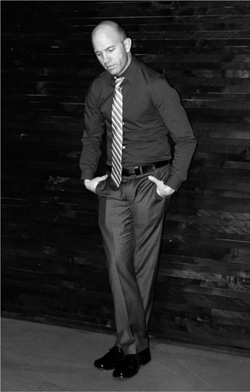
The Woody Allen hooking pose.
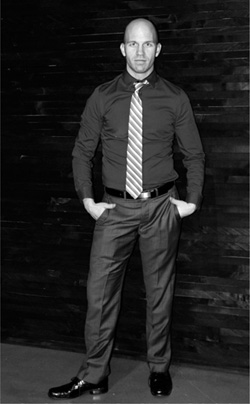
The James Dean hooking pose.
In the image on the left you can see my model, Kelly, standing in the Woody Allen hooking pose. His shoulders are down, slumped forward, and curled inward; his eyes are looking straight ahead; and his chin is tucked in. He looks as though he were ready to curl up in a ball and hide from the world. In the image on the right, Kelly is standing in a wide stance, with his feet about 10 to 12 inches apart. He has good posture, his shoulders are back, he maintains good eye contact with the camera, and his chin is lifted; he looks as though he were ready to take on the world. Change your stance, gentlemen, and you will change both how you feel and how others feel about you. Start doing this now! If you are a nice guy, and I hope you are, stand like this and you will get the girls; you will win in the end because eventually, girls leave the bad guys (or at least they should).
So why do guys frame their private parts, anyway? It’s as obvious as you think: It’s meant to communicate male sexuality. Male private parts are a symbol of male virility and power. How many times have you seen sexy bad boys on TV or in the movies assume this pose, and women can’t resist them? When males hook, or frame, their private parts, it signifies that they are a sexual threat and is meant to intimidate other men. It’s similar to the way in which a gorilla beats its chest to show strength and dominance and intimidate other male gorillas. When a guy hooks and positions one leg slightly higher than the other—for example, putting it on a footrest at a bar—he is subconsciously pushing out his private parts as a sign of extreme confidence, almost as though he were saying, “Hey, look at what I have to offer!” So why do women do it too? Both Angelina Jolie and fashion model Amber LeBon have been photographed this way. Are they trying to scare off male predators? No, they do it for the same reason: to show confidence and display one of their three vulnerable zones. If you expose your three vulnerable zones—your neck dimple, your belly, and your groin—you are subconsciously saying to the world, “Bring it on. I can handle anything.” It is display of power, and both girls and guys can display confidence and power this way. Women, if a guy does this at a bar while he’s staring at you or talking to you, he’s probably trying to impress you with his, um, good looks and pick you up.
As a general rule I tell people never to hide their hands, because when you hide your hands, you hide your emotions, and you will look insincere and untrustworthy. However, if you have to put your hands in your pockets, keep your thumbs out. As a modified phallic symbol, the thumb symbolizes power, and displaying the thumbs for all to see is a sign of confidence. I call exposing or displaying the thumbs in this way the “thumbs of power” because it’s a gesture of confidence, however subtle. You may not have noticed this, but when you are feeling strong and confident, the space between your fingers actually grows, making your hands take up more space. In essence they become more territorial. When you feel insecure, that space disappears; in fact, you may find yourself tucking your thumbs under your fingers or hiding your hands away completely. When you feel confident, your thumbs will tend to point upward as you speak. I have noticed over the years that when I get up and present, my thumbs are always sticking way out there, just like those of the Fonz! Who doesn’t remember the Fonz from Happy Days? His signature move was to raise both of his fists with thumbs out and say, “Heeeey!” The Fonz oozed confidence, strutting around in that leather jacket, white t-shirt, and blue jeans, and at the snap of his fingers, chicks would flock to him. Obviously it was a TV show and they were actors, but don’t you think there was a reason why the writer and director chose that body gesture to create the confident, chick-magnet image of the Fonz? Richie Cunningham never did that. The moment you hide your thumbs you’re saying “I feel insecure; I need reassurance.” Children hide their thumbs in their fists, and babies suck their thumbs because they feel insecure. As they grow older, most kids stop sucking their thumbs as they slowly become more confident in the world. I sincerely hope that you don’t still suck your thumbs, but definitely stop hiding them!
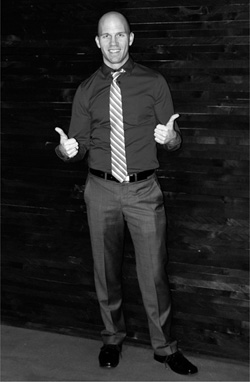
The Fonz thumbs of power.
This past News Year’s Eve I was invited to a five-course wine pairing dinner with friends. Across the table from me sat this beautiful, bubbly girl whom I just met named Leslie. She was full of life, open, and friendly. Once she found out what I did, she leaned in across the table, lowered her voice, and asked me, “Can you help me deal with this girl in my office who is always out to get me? She is always condescending and putting me down.” I replied, “I sure can.” After I had her explain the situation, I told her the next time she was around this girl in her work environment, she needed to exhibit confidence through body poses and gestures, because once she looked confident, she would feel confident. Here are some body confidence poses—power poses—and gestures that you can use to look and feel confident.
Power poses and belly breathing
In a paper published in Psychological Science, Amy Cuddy (of Harvard Business School), and Dana R. Carney and Andy J. Yap (both of Columbia University) reported how they measured the hormone levels of 42 male and female research subjects 17 minutes after they were placed either in a high-power or low-power poses for a minute per pose. They concluded that a mere two minutes in a pose caused significant changes in testosterone and cortisol. The high-power poses lead to increased feelings of confidence and a higher tolerance for risk. The study also found that people are more often influenced by how they feel about another person than by what that person is saying.
Try this the next time you get up in front of a room full of people to speak, or sit down for a job interview, or have a heart-to-heart conversation with a loved one that you are nervous or anxious about. Assume a power pose; plant your feet into ground about 10 inches apart and take a deep breath from your stomach, not your chest. If you breathe with your diaphragm, you will lessen anxiety, anger, and the feeling of panic. Diaphragm breathing is called belly breathing, and has very different effects than rapid chest breathing. Unfortunately, we have evolved into being chest breathers. As a point of comparison, watch a newborn baby breathe. What is rising and falling? The stomach, not the chest. With societal expectations for thinness and fitness, we have started to breathe from our chests rather than our stomachs. Who wants to walk around expanding their stomach, right? We are too busy sucking them in! What most don’t realize is that breathing from the stomach actually has a meditative, calming effect.
Back in the late 1990s, I wanted to lose weight and get on a health kick. I was tired of having a gut. Determined, I told myself I had to start running to lose weight, plain and simple. But up until that point as a 20-something, I had never run. I would get so nervous before I ran because I was worried I was going to collapse from being out of shape. So I started to run with really good posture to calm my erratic breathing (it was erratic from being completely out of shape and the resulting feeling of panic). I also ran with a band that weightlifters use to support their lower backs while lifting. This band actually helped support my posture and soon I was running outside in the middle of winter on a deserted beach in the dark three times a week, going farther and farther each time. The very first time I ran I barely ran a quarter of a mile before hyperventilating, but eventually I worked my way up to running five miles. How I got over the initial hump was all due to purposefully calming myself by having good posture and breathing deeply from my belly.
Another great power pose to take is the Wonder Woman or Superman pose. In both, you put your hands on your hips, with your feet about 10 inches apart, and stand with good posture. When your body is fully erect, your lungs and diaphragm can function better. Breathing deeply and calmly will start to transform how you feel; you will begin to feel calm and powerful. Trust me! Try it right now. While standing in this position I want you to think of a time when you felt your best, whether out of happiness or success. Take your time and think about what happened to cause to feel this way. Then mentally anchor those events to your body stance. Now that you have connected these positive thoughts and feelings to a power pose, every time you feel scared, nervous, weak, shy, or intimidated, go off somewhere by yourself and assume your power pose. Breathe deeply and think of your anchored thoughts of success and energy. Another good pose is the runner’s victory stance. Raise and extend your arms up into the air and stretch as far as you can. Why do you think all athletes do this when they win? They all do it instinctively. It reaffirms and increases the feeling of being victorious and strong. But you don’t have to be a world-class athlete do it!
I will warn you that assuming a power pose with others can come across as dominating and controlling. Be careful not to ruin rapport with someone by appearing superior to them; your purpose with this pose is to make yourself feel dominant, in control, and powerful. Also, avoid putting only one hand on your hip; you may think that this will help you appear confident but it actually sends a signal of disrespectfulness and defiance—that you are a know-it-all or you are about to lock horns with someone. If you want to look and feel confident, go with both hands on your hips. This is a positive, powerful pose.
Jodi Arias, one of my favorite recent criminal cases to analyze, assumed an extreme power pose the first time she was taken into custody and questioned by law enforcement personnel on July 15, 2008. This was after the body of her boyfriend, Travis Alexander, was found stabbed and shot in the shower in his home. In a YouTube video titled Jodi Arias Unedited Police Interrogation Video 5, she demonstrates some really odd behavior when she is left alone in the interrogation room where she was being recorded, unbeknownst to her. A detective enters to talk to her and reads her her rights. After they talk for a while he leaves, and she is left alone. You can hear he say out loud, “You should have at least done your makeup, Jodi. Gosh.” Then she starts to sing, plays with a water bottle, looks in a garbage can, laughs and says something inaudible, flips her hair, preens her finger nails, puts her knees up, twirls her hair, and then does a headstand! Debbie Pokornik, author of Standing in Your Power: A Guide for Living Your Life Fully Awake, says that when you put your feet above your head, it signals the body that it is safe and hence focuses its energies on making you healthy. It can also help you relax and release pent-up emotions. Maybe that’s why Jodi did one in the interrogation room. If you are emotional or lacking self-control and confidence, do a handstand. When I get super stressed or angry, to the point that my heart is palpitating and I am grabbing fists of my hair, I do handstand. After a few minutes I am calm as a still lake. Funny how that works!
Steepling
Steepling is another power pose. There are four ways to steeple: the regular church steeple (a Donald Trump favorite), the low steeple (an Oprah favorite), the handgun steeple (politicians’ favorite), and the basketball steeple (my favorite). No matter which steeple you use, it says you are knowledgeable, confident, and self-assured. It will make you feel powerful and confident. However, be careful of knowing when to use a steeple because it can come across as aggressive and domineering, especially the handgun steeple; only use this one as a last resort because it can make you lose rapport quickly.
The church steeple: Place all of your fingertips together in the shape of a church steeple and hold your hands out in front of your chest, or rest them on a surface in front of you. Some of you may be intimately familiar with this steeple. You also may have been steepled by someone else—your boss, an interviewer, a superior, anyone in a position of greater power. When people are contemplating an issue or about to make a decision they often will use a church steeple to show they have the knowledge and authority to make that decision. In the following image you can see Kelly steepling as he has a conversation with Chris; he is unconsciously saying he has the power and is in control. Chris, on the other hand, has his arms folded in a defensive manner. Although crossing the arms doesn’t always mean someone is defensive (it could just be that he is cold or thinking about something), here Chris has also leaned back, creating more distance between himself and Kelly. This tells me Chris is feeling more defensive than cold or contemplative. Be careful when you use the steeple; you may lose rapport and upset the other person. Although I highly recommend steepling a bully!

The church steeple.
The low steeple: The low steeple is the same as a church steeple but your hands are lowered almost covering your private parts. This steeple is subtler than the high church steeple. It stills says you feel powerful but you aren’t in shoving your confidence in people’s faces. It a subtle way to say, I ultimately have the control but I am not beneath hearing what you have to say either.
The basketball steeple: To do the basketball steeple, open your hands as though you were holding an imaginary basketball out in front of you. (Extraverts will actually go wider than a basketball to make the gesture bigger and grander.) The basketball steeple is a likeable gesture and makes you appear powerful yet approachable. This is the most effective steeple to get others to believe in you; it says you are hopeful but firm in your convictions. I use this unconsciously when I speak, probably because I feel I am the authority on the subject matter I am speaking about, but instead of fearing me, I want the audience to like me. Many public speakers use the basketball steeple; it’s a favorite gesture of President Barack Obama.
The low steeple.
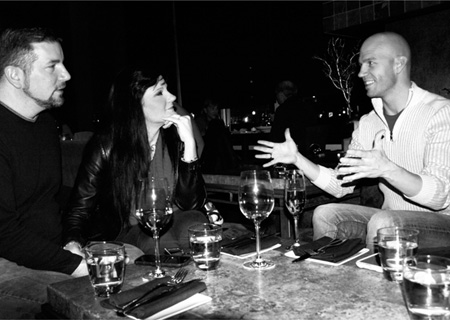
The basketball steeple.
The resting handgun steeple.
The handgun steeple: This steeple is downright aggressive. It says you mean business! The handgun steeple can be overbearing, controlling, and patronizing because you are unconsciously shooting down what other people say. In the image above you can see Kelly exhibiting a “resting handgun steeple”, in which his chin is resting on his “handgun.” Sometimes people rest the handgun steeple against their lips, which can be a sign of disapproval or deep thought, or an indication that an internal dialogue going on. It can also mean they are trying to keep their mouths shut. In the “shooting handgun steeple” the handgun is actually aimed at someone. This version is really aggressive because it looks as though you subconsciously want to shoot the other person. The handgun steeple should never be used when seeking diplomacy or when seeking agreement among peers. It should only be used when deliberately trying to intimidate another individual or group.

Hitler hands.
Hitler hands
This palm-down gesture, with the arm extended straight out like the Nazi salute or Hitler salute, is reprimanding and authoritative. It subconsciously says “Pay attention to me, or else.” I call this move “Hitler hands.” It has a stifling effect on others as it negates or nullifies what they have just said. This gesture is condescending—parents yell at children this way—but if you really want the upper hand, put your palm down.
The palm push.
Palm push
This gesture is very similar to Hitler hands but instead of putting your palm down, you show your palm to the other person; you are unconsciously saying, “Talk to the hand.” This is another condescending and rude gesture. It almost looks as though you are ready to shove it into someone’s face. Avoid using it, as you will not make any friends if you palm-push them.
The José pose
This pose is reserved for men only. If you are being palm-pushed by an office bully, push back by putting your hands behind your head, leaning back in your chair, and putting your legs in figure four or keeping them slightly open. (Women, you can see why this is not a good pose for you). This is the ultimate, uber-confident, slightly arrogant power pose. I call this the José pose because I worked with a former Army ranger by that name, and every time the boss would come into his office to chat, he would do that. This is the ultimate confidence pose! He feared no one. Remember this rule: When in doubt, spread out. Taking up space screams importance. Sitting in the José pose with your legs apart assures others that you are large and in charge.
The José pose.
The gorilla pose.
The gorilla pose
The gorilla pose is super effective when you want to deliver information with a punch. I tell salespeople to use this pose when they make their pitch, because people trust those who look confident. To do the gorilla pose, place your hands on a table, and lean over and in toward whoever is sitting nearby. By leaning in you appear to be more personable. If you want to appear even more personable and likeable, smile as you assume the gorilla pose. If you don’t, you will still come across as self-assured, but more aggressive than friendly (see the previous photo of Kelly). Depending on what the situation calls for, you can either smile or look more stern, as Kelly is here. I call this the gorilla pose because it resembles a gorilla when it is all puffed up, defending its territory.
Lift your chin
When you see a person walking around with their chin in the air, that person is seen as having an air of superiority. There is a joke about Extraverts and Introverts and it goes like this: “How can you tell if an introvert likes you? He looks at your shoes.” Think about it: You have look down your nose at someone when your chin is lifted in the air. But walking into a room with a wide gain and your chin lifted will not make you appear to be arrogant; it will make you look self-assured and confident. I always lift my chin, and when I do I have better posture and look and feel more powerful.
Don’t cover your neck dimple
The neck dimple, or jugular notch, is a very vulnerable part of the body. When we feel threatened, we unconsciously move to protect this vulnerable area. Our neck allows us to breathe, talk, and swallow. It also houses two carotid arteries that supply the head and neck with oxygenated blood, so if our necks were to be attacked, it could be life-threatening. In the movie Identity Thief, the signature move of Melissa McCarthy’s character is to finger strike people’s neck dimples, which then sends them crumpling to the floor. This is a real martial arts technique. Finger striking the neck dimple can induce choking and sometimes unconsciousness by crushing the windpipe.
My detainees who came into the interrogation booth scared and nervous would sit balled up, with their legs tightly pressed together, their elbows tucked glues to their sides, and one hand covering their neck. This hand would move to the back of the neck sometimes and then right back to the neck dimple. They would hold their necks literally for hours. After building rapport—sharing tea and something to eat, or maybe playing a game—the hand would slowly start to come down. When this happened I knew they were feeling more comfortable and so I would ease into my questions. When an uncomfortable topic came up, so did their hands, right to neck dimple in that protective yet unconscious gesture.
Both women and men cover their neck dimples in stressful situations. Men tend to grab their necks as if they were grabbing their beards and pulling them down, whereas women touch their necks more daintily, sometimes only with the tips of their fingers. In all my observations of colleagues, students, friends, and detainees, I can say that rubbing the neck and covering the neck dimple is an absolute sign of stress. The next time you are playing poker, or inquiring why your boyfriend didn’t answer your any of your texts last night, watch for the hands going to the neck. Start to pay attention to exactly when they touch their neck during the game or the conversation, because that’s the point at which stress is registering, albeit subconsciously.
The neck dimple is also considered to be an erogenous zone. When it’s exposed, it says “I’m open” (not to be confused with “I’m easy,” fellas). The bottom line about the neck dimple: If you want to appear sure of yourself, confident, and relaxed, do not put your hand anywhere on your neck, or your face for that matter!
So now you know how to position your body to look confident and how, ultimately, these positions and gestures will make you feel confident. Why do you need to be confident? Here’s why:
• You will need to start conversations with strangers and still appear confident, powerful, and likeable.
• You will need to be able to control those conversations without getting nervous.
• You will need to build rapport through establishing common ground, flattery, using your body language, changing your personality preferences, and being sincere and empathetic.
• You will need to read other people’s body language and baseline them.
• You will need to identify behavioral incongruence through observing deviations in baseline behavior.
• You will need to probe those topics that were being discussed when you observed those deviations with good questioning techniques to uncover the truth.
You need confidence in order to be able to do all of that successfully. The next time you need to confront a bully or stand up for yourself, do the following. First, correct your posture to relax your breathing. Then, widen your stride and walk authoritatively up to the person in question and stand like Superman or Wonder Woman, with 10 inches or so between your feet, raise your chin, and lean in as you address this person, making sure you deepen your voice. Don’t forget to smile! You want to be congenial and authoritative at the same time. You will exude confidence, and no bully is going to mess with that. But if you don’t feel confident, the bully will see through you and walk all over you. If you need to, you have your steepling techniques and your power poses. If all else fails, use your Hitler hands or the palm push, but only as a last resort!
The confident voice
Even controlling your voice will help you transform how you feel. Speak more loudly and clearly, emphasize key syllables and points, lower the pitch of your voice, “chunk” the information you’re conveying, and incorporate pauses so that people have time to digest what you’re saying. When the pitch of your voice goes up, and your voice gets softer and more muffled, that is a sure indicator that you’re feeling insecure and nervous. Have you ever seen the talk show Outnumbered on the Fox News channel? It is comprised of four female newscasters and one male newscaster (hence the name Outnumbered) discussing current news events. One of the female panelists is Harris Faulkner. Her voice, above those of all the other female panelists, exudes authority because she speaks in a lower pitch. I want to listen to her because she sounds and appears to be more confident than the other female panelists. Plus, I’m more apt to believe what she has to say.
I have spoken to audiences from all different professional backgrounds—health and safety investigators, auditors, arson investigators, pediatric dentists, small-business owners, and entrepreneurs—on body language, detecting deception, and enhanced communication skills. This past year I noted an unfortunate trend. After my speaking engagements, professional women would constantly come up to me and ask me how they should deal with an office bully. It’s saddens me to think that women are feeling bullied or threatened at work. To those of you reading this who are in that situation, use what I have outlined in this chapter. You will change the dynamic you have with this person, I promise you!
The next chapter is all about how to build rapport, even with a perfect stranger. I will teach techniques on how to get people to like you, feel comfortable around you, want to be around you, look to you as a leader, listen to you, ask for and take your advice, and respect you. Potential outcomes could include getting a promotion or raise, diffusing an argument between others, winning a case by convincing a jury, having a criminal confess to you, having your family and friends be open and honest with you, and, best of all, surrounding yourself with positive people. Does all of that sound good? Then read on!
